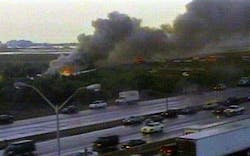All 309 Miraculously Survive Air France Crash in Toronto
TORONTO (AP) -- All 309 passengers and crew aboard an Air France jet survived a dramatic runway crash by sliding down escape chutes from the burning plane and scrambling up a ravine during a pounding thunderstorm.
The plane skidded off the runway at Toronto's Pearson International Airport after landing at around 4 p.m. Tuesday in a heavy rain storm accompanied by lightning and strong winds, said Steve Shaw, a vice president of the Greater Toronto Airport Authority. The Airbus A340 slid down a slope into a wooded area that runs along Highway 401, Canada's busiest thoroughfare.
''It's nothing short of a miracle,'' Canada's Transport Minister Jean Lapierre said after learning everyone on board Air France flight 358 from Paris had survived.
Air France Chairman Jean-Cyril Spinetta on Wednesday said it was too early to determine the cause of the crash but promised the airline would be ''totally transparent'' in any investigation. He said Air France bought the aircraft new on fall 1999. It was last serviced July 15 and had logged 28,418 flight-hours and 3,711 takeoffs and landings, he said.
Spinetta said the plane's co-pilot reported that the plane had sufficient fuel at the landing and that the runway was long enough.
Air France said 22 people were treated for minor injuries, though Shaw said 43 were hurt. Passengers said some of the injured had broken arms and legs.
The first sign of trouble came minutes before landing when the pilot aborted an initial attempt to land the plane because of the storm and powerful winds. About a minute before the plane landed, as it approached the airport for a second time, the lights in the cabin went out, said passenger Olivier Dubois.
''Just before touching ground, it was all black in the plane, there was no more light, nothing,'' he said.
As the wheels touched down, passengers - their nerves frayed by the darkness inside and outside the cabin and flashes of lightning - burst into applause.
But then the jet thudded on landing, skidded off the runway and burst into flames, passengers recounted.
''It happened so quickly; it was a little bit like being in a movie,'' said Gwen Dunlop of Toronto, who was returning from a vacation in France.
Dunlop said some passengers went down emergency chutes, while others just jumped out on their own.
''We were all trying to go up a hill; it was all mud and we lost our shoes. We were just scrambling, people with children.''
Pouring rain, lightning and thunder added to the drama.
The federal agency Environment Canada had issued a severe weather alert earlier in the day, saying its radar showed a rapidly developing thunderstorm with winds of about 60 mph. Shaw said the airport had been under a ''red alert'' since noon, which indicates potential for lightning, but does not prevent planes from landing or taking off.
Moments after the crash , a portion of the plane's wing could be seen jutting from trees as smoke and flames poured from the middle of its broken fuselage. A row of emergency vehicles lined up behind the wreck, and a fire truck sprayed the flames with water.
Some of the 297 passengers and 12 crew members who evacuated reached the nearby highway crowded with rush hour travelers.
''We located the co-pilot on Highway 401,'' said police Sgt. Glyn Griffiths.
Lauren Langille, 15, was flying back from France with an exchange student who was coming to live with her Toronto family.
''There was a lot of panic, but the flight attendants were really good at calming you down,'' said Langille, who was greeted by her father carrying helium balloons.
But Dunlop said the staff did not handle the emergency well.
''One of the hostesses said, 'You can calm down, it's OK,' and yet the plane was on fire and smoke was pouring in,'' Dunlop told The AP. ''I don't like to criticize, but the staff did not seem helpful or prepared.''
Several hours after the crash, passengers in red blankets were taken on buses to the airport Sheraton hotel to meet relatives and friends. Some were distressed that they had to go through customs before they were reunited.
The accident was the first crash landing of an Airbus A340 in its 13 years of commercial service.
Chris Yates, an aviation specialist with Jane's Transport magazine, said the A340 has a very good safety record and weather appeared to be the cause of the accident.
''You can never account for weather,'' Yates said. ''A thunderstorm can happen anywhere - it comes down to the judgment of the air traffic controller and the skill of the pilot to determine whether it's appropriate to land or to divert elsewhere.''
The most serious plane crash at Pearson, Canada's busiest airport, was more than 30 years ago. In 1970 an Air Canada DC-8 jet, en route from Montreal to Los Angeles, went down north of the airport, killing all 109 people aboard.
The last major jet crash in North America was on Nov. 12, 2001, when American Airlines Flight 587 lost part of its tail and plummeted into a New York City neighborhood, killing 265 people. Safety investigators concluded that the crash was caused by the pilot moving the rudder too aggressively.
_____
Associated Press reporters Carolyn Thompson in Buffalo, N.Y., and Rebecca Cook in Toronto contributed to this report.
